
views
Designing the Frame

Find the area of the designated wall or window in square inches. The size of your project depends on the installation area. Use a tape measure and take an accurate measurement of the length and height of the work area. Then calculate the area of the space. Since glass blocks are measured in inches, convert your measurements to inches first. If you’re filling a window that’s 4 feet (1.2 m) by 6 feet (1.8 m), convert each side to inches first: 48 inches (120 cm) by 72 inches (180 cm) is 3,456 square inches (22,300 cm). If you’re building a free-standing block wall, then it won’t have a defined frame in place. In this case, measure the height and length that you want the wall to be and mark these spots on the floor and wall. If you're installing these blocks on a wall to make a window, make sure the wall can support the weight first. These blocks are much heavier than a normal window, so the wall needs to be strong enough. Ask a contractor to assess your wall strength if you aren't sure.

Calculate how many blocks you need for the project. After taking your measurements, figure out how many materials you need for the project. The average glass block is 8 in (20 cm) by 8 in (20 cm) by 4 in (10 cm). Since glass blocks can only be installed 1-across, calculate the area of each block to get 64 sq in (410 cm). Then divide 64 into the area measurement you took of the installation area. If you’re filling a window that’s 4 feet (1.2 m) by 6 feet (1.8 m), convert each side to inches first. 48 inches (120 cm) by 72 inches (180 cm) is 3,456 square inches (22,300 cm). 64 divided into 3,456 is 54, so you need 54 blocks for the project. The area of the blocks may not evenly divide into the work area. In this case, round down, since you can’t cut glass blocks. If you received a calculation of 35.6 blocks, for example, use 35 blocks.
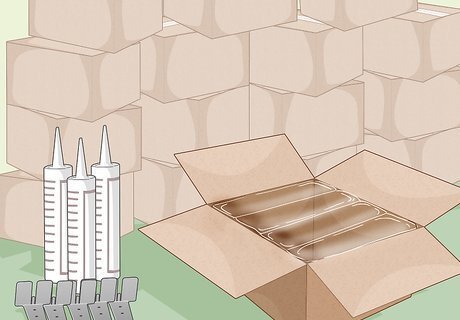
Buy the correct number of glass blocks and an installation kit. After calculating how many blocks you need for the job, purchase that amount. Also get an installation kit that comes with the correct mortar or glue, spacers for the blocks, and landing strips. These kits are available at hardware stores or online. Different installation kits may come with different materials. Speak with a store employee and tell them what job you're planning. Use their advice to pick the correct installation kit. If you can't find complete installation kits, most of the materials are available separately. Get mortar designed for glass blocks, spacers, and PVC base strips along with the glass blocks.
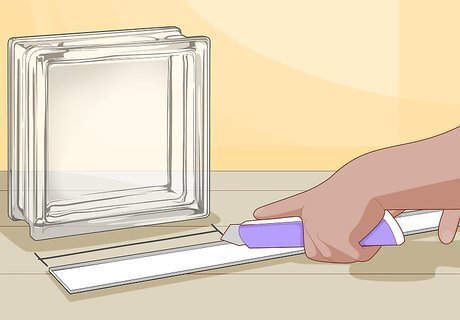
Cut PVC landing strips to the length and height of your glass block wall. Glass block installation kits come with PVC bases to rest the blocks in. Take one and measure it to the length of the wall, then cut it. Do the same with a PVC strip for the height of the glass block wall. If the glass blocks will be filling a square space, then cut 4 landing strips, 2 for the length and 2 for the height. If the blocks are free-standing, then cut 2, 1 for the base and 1 for the height. If you’re installing the blocks outdoors or in a wall, professionals recommend using wood for your base instead. Use a 1 in (2.5 cm) by 6 in (15 cm) board and cut it to the length of the wall. Then screw it down to it provides a stable base. Some landing strip kits have perforations measured to the length of standard blocks. Snap along these lines if your kits are designed this way.
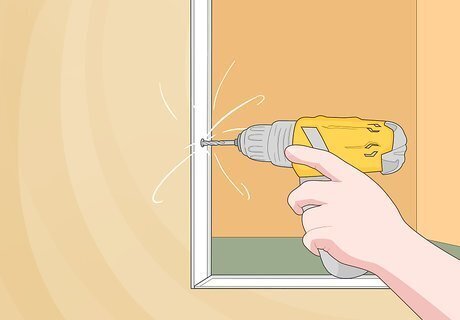
Screw the support strips to the wall and floor. Lay out the base strip where you want to start the block installation. Make sure it’s straight. Then drill screws through the marked spots on the strip. Repeat the process for the wall supports. The markings are usually every 1 foot (0.30 m), but follow the guide marks on your kit. Some installation kits have screw plugs that go into the floor and wall before you drill the screws. Always follow the instructions provided on your installation kit.
Laying the Blocks
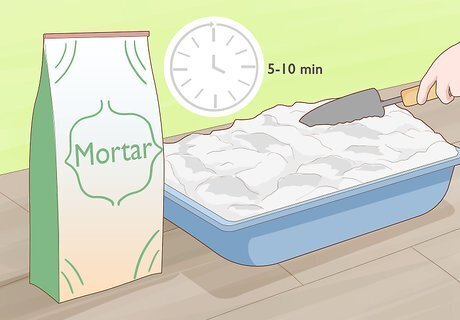
Mix the mortar to bond the blocks together. Your installation kit may come with a bonding material. Otherwise, buy a mortar designed for use with glass blocks from a hardware store. Measure out the amount of water that the mortar instructs you to use and pour it into a bucket. Then add the mortar and mix it with a shovel in a circular motion. Mix for 5-10 minutes, until the mortar becomes a thick paste. The mortar packaging should indicate how many blocks the package will cover. You may need to buy more than 1 pack, depending on the size of the job. If you have an electric mixer, this will make the job much faster. For some installations, like a shower, professionals recommend using caulk instead of mortar. Always check with the instructions provided on the product you’re using.
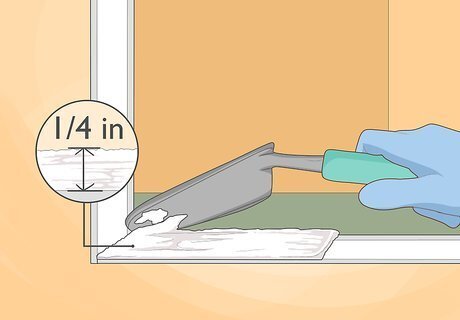
Spread a ⁄4 in (0.64 cm) layer of mortar in the base corner of the installation. Always start in the corner when you’re installing glass blocks. Scoop some mortar with a trowel and spread it on the floor and wall of the corner. If the installation area has 2 base corners, then you can start in either one. Start the installation right after mixing the mortar so it doesn’t harden before you’re done.

Place a corner spacer into the mortar. Installation kits come with spacers to place between the blocks. Take a corner spacer and press it into the mortar at the corner. Make sure it touches the floor and wall directly, rather than floating on the mortar.
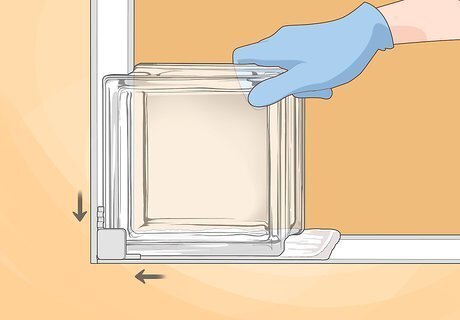
Press the first block into the corner. Start by rubbing a thin layer of mortar on the side and bottom edges of the block that will contact the mortar. Then press it down into the corner so it rests on top of the spacer. Scrape away the mortar that bleeds out when you push the block down.
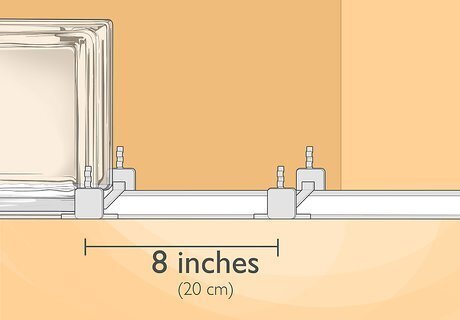
Place 2 spacers 8 inches (20 cm) apart from the first block. These spacers go in between each block and remain there permanently encased in the mortar. Take the first one and press it into the corner of the first block. Then lay a second one 8 inches (20 cm) away. If the blocks you’re using are a different size, distance the spacers the length of the block instead. If the spacers still show after you press the blocks together, touch up the area with a bit more mortar to cover them. Alternatively, you could seal the mortar with caulk when it's cured. This will cover any spacers or other imperfections.

Spread mortar between the 2 spacers. Scoop out some more mortar and spread it ⁄4 in (0.64 cm) thick until you reach the second spacer. If the end spacer moves while you’re spreading the mortar, place it back into position. Then spread mortar onto the side of the first block.
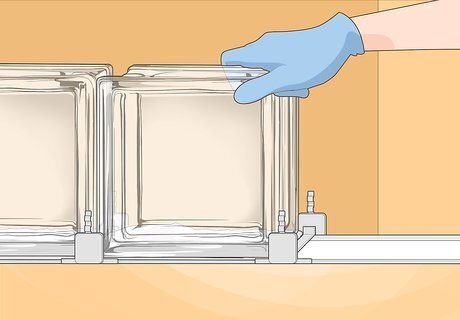
Press the second block into position. Spread mortar on the side and bottom edges of the block. Then press it down between the 2 spacers. Push it against the first block so the mortar binds them together. Don’t press so hard that the blocks are closer than ⁄4 in (0.64 cm) apart. Maintain that separation between all the blocks in this job. If you're using glue or caulk to bond the blocks instead of mortar, then place a plastic strip between each block with glue on each side. These strips should come with an installation kit that uses glue.

Continue working down the line until you complete the first row. Follow the same procedure to lay each block. Place the spacers down, spread mortar on the floor and block, then press the block down so it’s ⁄4 in (0.64 cm) from the base and previous block. Work until the first layer of blocks is complete. Remember to scrape away excess mortar that comes out from between the blocks. It’s okay to have some leftover on the blocks, but a large glob of excess mortar will be difficult to clean later on.
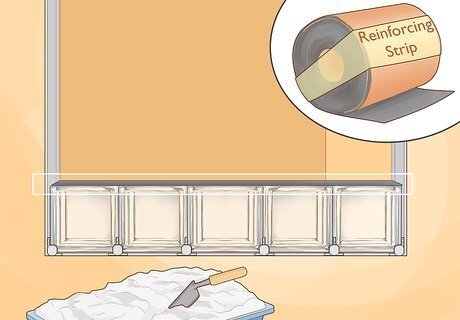
Attach a reinforcing strip across the top of the blocks. Once the first row is complete, reinforce the blocks before starting the second row. Installation kits come with reinforcing strips that go in between rows. Take the strip and screw it to the wall on one side. Then stretch it across the blocks, making sure it touches each one. Then screw it to the wall on the opposite side. The strips may be pre-cut, or you may have to cut them to the correct size. Cut them to the length of the wall plus 6 inches (15 cm) on each side to allow room for the screws. If the glass blacks are free-standing and aren’t enclosed by a wall on both sides, then extend the reinforcing strip until the end of the last block in the row. Some installation kits have different types of reinforcing strips that don’t screw to the wall. Instead, you’d spread glue or mortar on the strip and press it onto the blocks. Follow the directions provided for the correct reinforcement method.
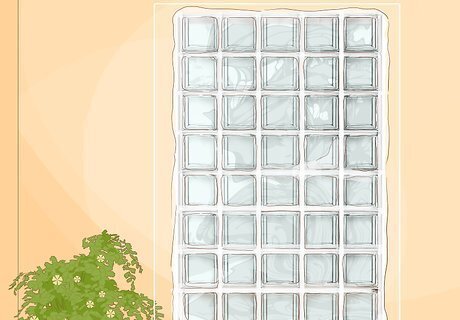
Build row-by-row until you complete the installation. Repeat the same process for each row. Place spacers down, spread the mortar, and press each block down. When you complete a row, reinforce it with a reinforcing strip. Continue the process until you’ve install all the blocks.
Finishing the Job and Maintaining the Blocks
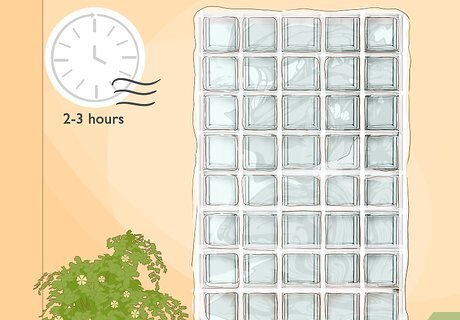
Let the mortar set for 2-3 hours before washing the blocks. Even though you scraped away excess mortar, there is almost certainly some leftover on the blocks. The washing process removes all of these imperfections, but not until the mortar has set. Give it 2-3 hours before you start washing. This set time only makes the mortar strong enough for scrubbing. The mortar won’t reach it’s full strength until it’s set for several weeks. This job may take several hours, meaning that the first blocks you laid are dry enough for cleaning as soon as you complete installing the blocks.
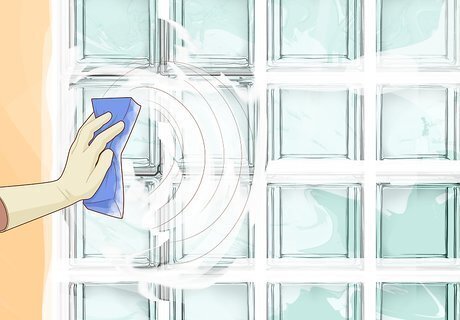
Scrub the blocks with a wet sponge. Dip a sponge in a bucket of plain, warm water and scrub any spots on the blocks that have mortar on them. Thin layers of mortar should come off easily with water and light scrubbing. Dip the sponge back into the bucket periodically to wash off excess mortar. Only use plain water at this point. The mortar is not dry enough to handle cleaning from solvents or other chemicals.
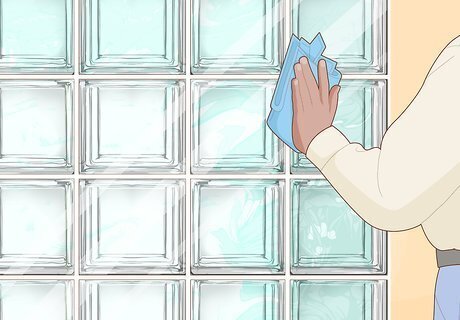
Run a dry cloth over the blocks after cleaning them. This wipes up any moisture and removes any remaining mortar remnants. Work in a circular motion and cover both sides of the block surface.

Let the mortar cure for 14-21 days. Once the job is complete, leave the mortar to dry. Don't do any additional cleaning or maintenance until the mortar has fully cured. Avoid doing any construction near the blocks, or the vibrations could knock them out of place. If the blocks are outside, cover them with plastic to prevent rain from getting on them. Different mortar may have different set times. Always check the instructions on the product you use for the specific dry time.
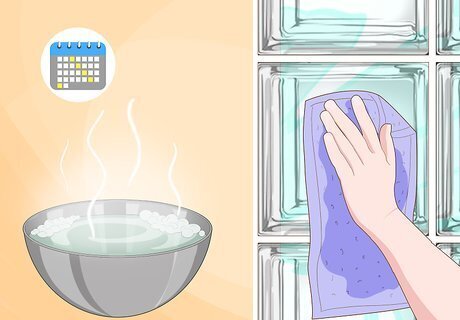
Maintain your glass blocks by cleaning them once a week. After the mortar dries completely, start cleaning the glass blocks once a week. Make a solution of warm water and mild soap. Dip a fine cloth or sponge into the water and scrub the blocks in a circular motion. Then use a squeegee to wipe the water off. Remember to clean both sides of the installation.



















Comments
0 comment